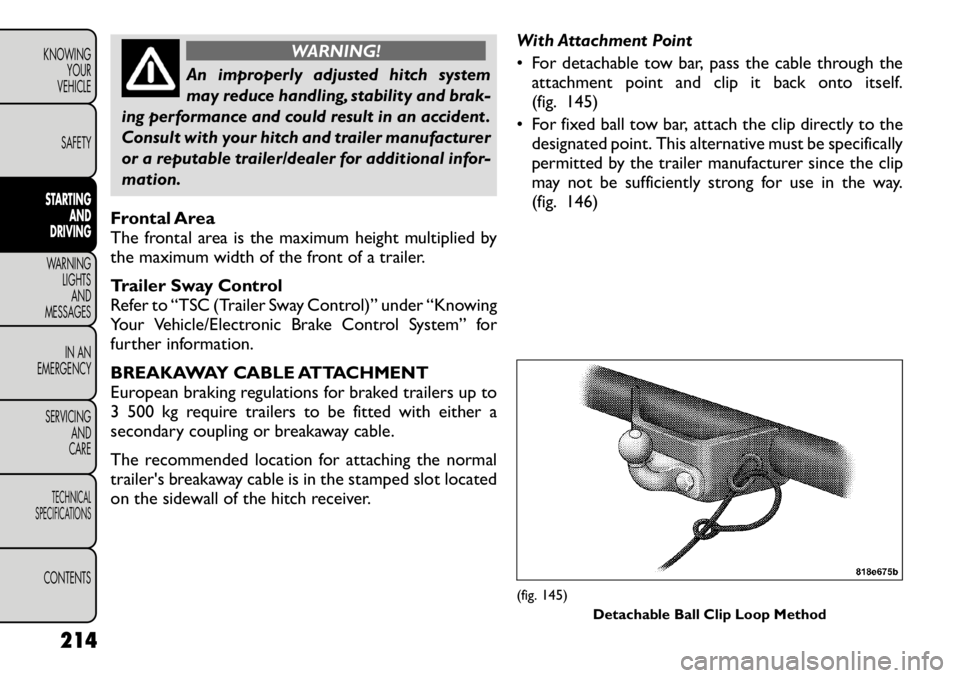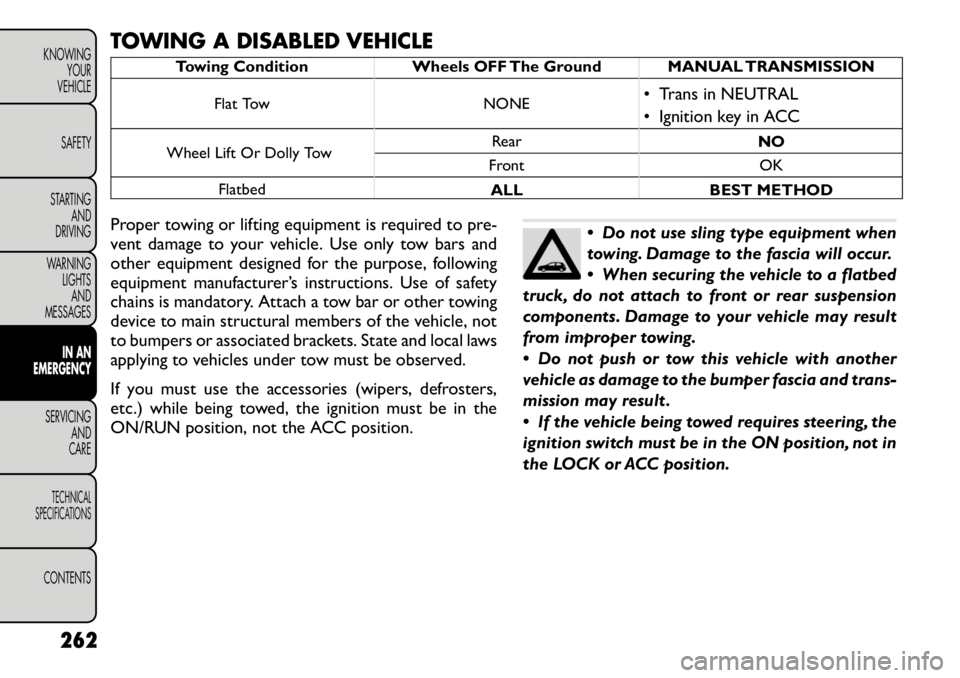tow bar FIAT FREEMONT 2012 Owner handbook (in English)
[x] Cancel search | Manufacturer: FIAT, Model Year: 2012, Model line: FREEMONT, Model: FIAT FREEMONT 2012Pages: 332, PDF Size: 5.61 MB
Page 220 of 332

WARNING!
An improperly adjusted hitch system
may reduce handling, stability and brak-
ing performance and could result in an accident .
Consult with your hitch and trailer manufacturer
or a reputable trailer/dealer for additional infor-
mation.
Frontal Area
The frontal area is the maximum height multiplied by
the maximum width of the front of a trailer.
Trailer Sway Control
Refer to “TSC (Trailer Sway Control)” under “Knowing
Your Vehicle/Electronic Brake Control System” for
further information.
BREAKAWAY CABLE ATTACHMENT
European braking regulations for braked trailers up to
3 500 kg require trailers to be fitted with either a
secondary coupling or breakaway cable.
The recommended location for attaching the normal
trailer's breakaway cable is in the stamped slot located
on the sidewall of the hitch receiver. With Attachment Point
• For detachable tow bar, pass the cable through the
attachment point and clip it back onto itself.
(fig. 145)
• For fixed ball tow bar, attach the clip directly to the designated point. This alternative must be specifically
permitted by the trailer manufacturer since the clip
may not be sufficiently strong for use in the way.
(fig. 146)
(fig. 145)
Detachable Ball Clip Loop Method
214
KNOWING YOUR
VEHICLE
SAFETYSTARTING AND
DRIVINGWARNING LIGHTSAND
MESSAGES
IN AN
EMERGENCY
SERVICING AND
CARETECHNICAL
SPECIFICATIONSCONTENTS
Page 221 of 332

Without Attachment Points
• For detachable ball tow bar, you must follow therecommended manufacturer or supplier procedure.
(fig. 147)
• For fixed ball tow bar, loop the cable around the neck of the tow ball. If you fit the cable like this, use a single
loop only. (fig. 148)(fig. 146)
Fixed Ball Clip Loop Method
(fig. 147)Detachable Ball Neck Loop Method(fig. 148)
Fixed Ball Neck Loop Method
215
KNOWING
YOURVEHICLE SAFETYSTARTING ANDDRIVINGWARNING LIGHTSAND
MESSAGES
IN AN
EMERGENCY
SERVICING AND
CARETECHNICAL
SPECIFICATIONSCONTENTS
Page 268 of 332

TOWING A DISABLED VEHICLE
Towing Condition Wheels OFF The Ground MANUAL TRANSMISSIONFlat Tow NONE • Trans in NEUTRAL
• Ignition key in ACC
Wheel Lift Or Dolly Tow Rear
NO
Front OK
Flatbed ALL BEST METHOD
Proper towing or lifting equipment is required to pre-
vent damage to your vehicle. Use only tow bars and
other equipment designed for the purpose, following
equipment manufacturer’s instructions. Use of safety
chains is mandatory. Attach a tow bar or other towing
device to main structural members of the vehicle, not
to bumpers or associated brackets. State and local laws
applying to vehicles under tow must be observed.
If you must use the accessories (wipers, defrosters,
etc.) while being towed, the ignition must be in the
ON/RUN position, not the ACC position.
Do not use sling type equipment when
towing. Damage to the fascia will occur.
When securing the vehicle to a flatbed
truck, do not attach to front or rear suspension
components. Damage to your vehicle may result
from improper towing.
Do not push or tow this vehicle with another
vehicle as damage to the bumper fascia and trans-
mission may result .
If the vehicle being towed requires steering, the
ignition switch must be in the ON position, not in
the LOCK or ACC position.
262
KNOWING YOUR
VEHICLE
SAFETY
STARTING AND
DRIVING
WARNING LIGHTSAND
MESSAGES
IN AN
EMERGENCY
SERVICING AND
CARETECHNICAL
SPECIFICATIONSCONTENTS